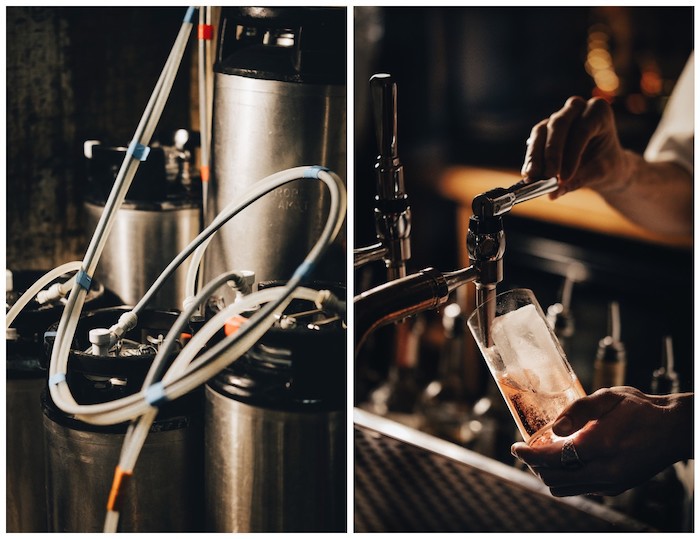
Bart Miedeksza and Valentino Girotto, formerly of Crossroads Bar, published the book Bubbles with the help of Millie Milliken this summer. Guest writing in Class, the duo outline the key principles involved in this short but sparkling guide to carbonation.
At Crossroads, our journey into carbonation began even before we opened our doors in 2020. We were fascinated by the idea of controlling every detail of our cocktails, bubbles included. Why settle for a drink topped with soda water when we could have complete control over the entire carbonation process? This way, we could ensure every flavour was perfectly blended, every bubble was the right size, and the temperature was just right. Plus, with everything prepped and ready to go, we had more time to focus on what truly matters – hospitality.
We spent countless hours experimenting with different sugars, aromatic compounds and bubble sizes. The results varied, but each trial taught us something new. Over months of testing and tweaking, Crossroads transformed into a bubbling lab of creativity and innovation. Our dedication to mastering carbonation didn’t just change how we made drinks; it reshaped our entire approach to bartending. We embraced a culture of curiosity and a relentless pursuit of perfection.
To truly understand carbonation, you need to grasp the science behind it. With insights from our technical scientific advisor, Richard Amaee, who has a PhD in biochemistry from the University of Cambridge, we delved into the physics of bubbles. Concepts such as Henry’s Law and Le Châtelier’s principle of equilibrium are essential for mastering the art of carbonation. This guide is a distillation of everything we’ve learned, outlining the key elements of the process.
The essence of fizz
What does “fizzy” mean to you? Through our research and experience, we’ve learned that “fizzy” isn’t just a feeling; it’s that effervescent tingling on your tongue when sipping a carbonated drink. But everyone’s idea of perfect carbonation is different. For some, it’s the big, aggressive soda bubbles of summer.
For others, it’s the light foaming sensation of a post-shift beer. For champagne lovers, it’s the delicate, elegant bubbles that make any night feel special. Understanding what “fizzy” means to you and your customers is crucial for recreating and enhancing those moments.
When you open a soda can, a carbonated cocktail, or pour a beer, you’re triggering a reaction. The bubbles that explode from your drink, the “hiss” you hear, and the foam that forms on top are all gas trying to escape your liquid. From a scientific point of view this is Henry’s Law in action, which is a vital principle in cocktail carbonation.
Like in fermentation, carbonation is all about understanding the ideal environment, but instead of your yeast and bacteria you are creating the ideal environment for CO2. Carbonation is about understanding the gas’s comfort zone – what it likes and dislikes. There are five main pillars of carbonation:

1. Pressure First up, obviously, pressure, the undisputed queen of carbonation. “Increase the pressure, and you get more gas dissolved in your liquid.” In theory this would lead to higher fizziness but over-carbonation is a factor. You need to have control over it – there’s more on this in our book.
2. Temperature As temperature goes up, gas solubility goes down. Warm liquids just don’t hold on to bubbles as well as cold ones. So, keep your drinks chilled to maintain that fizz.
3. Time & Space The way you treat your drink while it’s carbonating also will have an impact on the final result. Allow enough time for the process to happen and increase surface area of contact between gas and liquid and you are on the right path for a perfect Highball.
4. Acidity This element plays a crucial role in the entire process of carbonation, from gas solubility to preservation of the liquid.
5. Sugar While great for taste, sugar isn’t bubbles’ best friend. Higher sugar content can lower gas solubility, which can lead to flatter drinks. Balancing sweetness with carbonation is key to achieving the right texture.
There are additional factors too, such as alcohol content (abv), protein, and impurities that influence how your drink will behave after carbonation. And don’t forget how carbonation can amplify or downplay certain flavours, fusing some together. We dive into all of this in our book Bubbles: A Guide to Carbonated Cocktails, which is a journal of our findings, tested methods, equipment tips, and quick fixes. We hope you find them as useful as we have on your journey to the perfect fizz.


